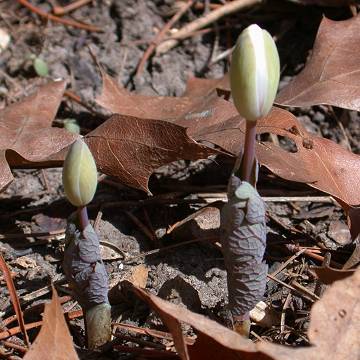

Sanguinaria canadensis - (image 1 of 7)
Taxonomy
Family: Papaveraceae
Habitat
Rich woods. Old, shaded dune slopes.
Associates
In rich woods with Actea pachypoda, Adiantum pedatum, Allium burdickii, Botrychium virginianum, Caulophyllum thalictroides, Claytonia virginica, Dentaria laciniata, Dicentra cucullaria, Erythronium albidum, Galium aparine, Geranium maculatum, Hepatica acutiloba, Isopyrum biternatum, Smilacina racemosa, Thalictrum dioicum, Uvularia grandiflora.
Distribution
Nova Scotia west to southern Manitoba, south FL to eastern TX.
Morphology
Herbaceous perennial to 10" high. Leaf solitary, basal, orbicular, palmately veined and lobed, glabrous; 5-9 obovate lobes. Flower solitary on a basal stalk; petals white, 8-10, oblanceolate; stamens yellow-orange; sepals 2, deciduous as the flower opens (visible in images). Fruit a capsule, 2-parted.
Notes
Flowers late March to early May
Wetland indicator: Facultative Upland -
This plant transplants easily and forms small vegetative colonies over time. The roots and stem exude an acrid red-orange juice when cut, giving the appearance that the plant is "bleeding". Bloodroot contains alkaloids that can depress the central nervous system.
References
Foster, S. and R.A. Caras. 1994. A Field Guide to Venomous Animals and Poisonous Plants: North America North of Mexico.
Houghton Mifflin Company. New York, NY. 244 pp.
Niering, W. A. 1979. The Audubon society field guide to North American
wildflowers: eastern region.
Knopf/Random House, New York.
Swink, F. and G. Wilhelm. 1994. Plants of the Chicago Region.
Indiana Academy of Science. The Morton Arboretum. Lisle, Illinois.
|
Michael Hough © 2005 |